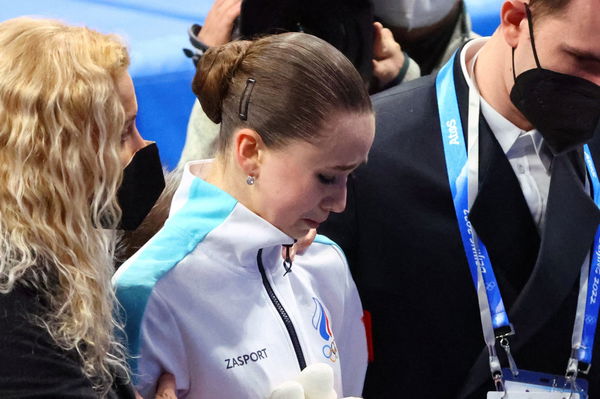
via Reuters
2022 Beijing Olympics – Figure Skating – Women Single Skating – Free Skating – Capital Indoor Stadium, Beijing, China – February 17, 2022. Kamila Valieva of the Russian Olympic Committee reacts after competing with coaches Daniil Gleikhengauz and Eteri Tutberidze of the Russian Olympic Committee. REUTERS/Fabrizio Bensch TPX IMAGES OF THE DAY

via Reuters
2022 Beijing Olympics – Figure Skating – Women Single Skating – Free Skating – Capital Indoor Stadium, Beijing, China – February 17, 2022. Kamila Valieva of the Russian Olympic Committee reacts after competing with coaches Daniil Gleikhengauz and Eteri Tutberidze of the Russian Olympic Committee. REUTERS/Fabrizio Bensch TPX IMAGES OF THE DAY
The pall of gloom that doping has cast on sports since a millennium is one of great peril. Earlier this year, Russian figure skater Kamila Valieva grabbed headlines but not for a good reason. The 17-year-old prodigy found herself embroiled in a doping controversy, casting a shadow over her promising career.
Valieva faced the consequences of an anti-doping rule violation stemming from a positive test prior to the 2022 Winter Olympics in Beijing. As a result, she received a substantial four-year ban from the sport. Her test revealed the presence of the banned substance trimetazidine.
ADVERTISEMENT
Article continues below this ad
The case of Kamila Valieva vs. Chinese Swimmers – why the disparity in doping rulings?
In a parallel story, the news of 23 Chinese swimmers being permitted to participate in the Tokyo Olympics despite testing positive for the same banned substance, which is trimetazidine. This substance helps with heart issues by boosting blood circulation and keeping blood pressure steady. The World Anti-Doping Agency (WADA) banned it since 2014 categorizing it as a “hormone and metabolic modulator.”

ADVERTISEMENT
Article continues below this ad
Athletes are not allowed to use it during or outside of competitions because it is thought to improve performance possibly creating an edge. But what if there was a reason for Kamila Valieva to take it? Kamila Valieva attributed her positive doping test to a strawberry dessert allegedly contaminated by her grandfather’s use of a chopping board previously used to crush his medication pills, including TMZ, a drug for preventing angina.
However, the Court of Arbitration for Sport dismissed this explanation, stating it lacked concrete evidence and failed to establish her innocence. Despite Valieva’s age, CAS concluded that she could not prove she didn’t intentionally commit the anti-doping rule violation, thus denying any leniency typically granted to athletes under the “no significant fault or negligence” criterion. But why were Chinese swimmers allowed still allowed?
ADVERTISEMENT
Article continues below this ad
Were Chinese swimmers’ positive tests validated or masked?
It has come to light that twenty-three Chinese swimmers had tested positive for TMZ, months before the 2020 Tokyo Olympics. Surprisingly they were allowed to participate despite this. How did this happen? The World Anti-Doping Agency (WADA) accepted the explanation given by officials stating that the positive tests were due to contaminated food ingested by the swimmers at their hotel.
The joint investigative report revealed that the Chinese anti-doping agency, CHINADA, had submitted a 61-page dossier to WADA in 2021, citing traces of TMZ found in various parts of the hotel kitchen in Shijiazhuang where the swimmers had lodged. Despite assertions of contamination, questions lingered over the plausibility of the explanation, with critics highlighting discrepancies in the investigation’s findings. Nevertheless, WADA opted not to challenge the Chinese authorities’ assertion, citing logistical challenges posed by Covid-related restrictions at that time and the absence of conclusive evidence to refute the contamination narrative. Hence, they were not banned.
ADVERTISEMENT
ADVERTISEMENT
ADVERTISEMENT
ADVERTISEMENT

